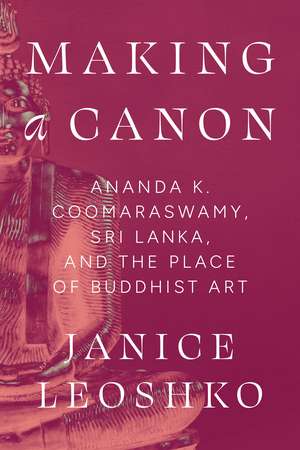Making a Canon: Ananda K. Coomaraswamy, Sri Lanka, and the Place of Buddhist Art: Buddhism and Modernity
Autor Janice Leoshkoen Limba Engleză Hardback – 11 dec 2024
An early interpreter of Buddhist art to the West, Ananda Kentish Coomaraswamy laid the foundation of what would become the South Asian visual canon, particularly through his efforts to understand how Buddhist art emerged and developed. In Making a Canon, Janice Leoshko examines how Coomaraswamy’s experience as the director of a mineralogical survey in Sri Lanka shaped his understanding of South Asian art and religion. Along the way, she reveals how Coomaraswamy’s distinctive repetition of Sri Lankan visual images in his work influenced the direction of South Asia’s canon formation and left a lasting impression on our understanding of Buddhist art.
Preț: 302.48 lei
Nou
Puncte Express: 454
Preț estimativ în valută:
57.88€ • 60.59$ • 47.89£
57.88€ • 60.59$ • 47.89£
Carte disponibilă
Livrare economică 15-29 martie
Livrare express 04-08 martie pentru 39.15 lei
Preluare comenzi: 021 569.72.76
Specificații
ISBN-13: 9780226836065
ISBN-10: 0226836061
Pagini: 304
Ilustrații: 58 halftones
Dimensiuni: 152 x 229 x 20 mm
Greutate: 0.54 kg
Editura: University of Chicago Press
Colecția University of Chicago Press
Seria Buddhism and Modernity
ISBN-10: 0226836061
Pagini: 304
Ilustrații: 58 halftones
Dimensiuni: 152 x 229 x 20 mm
Greutate: 0.54 kg
Editura: University of Chicago Press
Colecția University of Chicago Press
Seria Buddhism and Modernity
Notă biografică
Janice Leoshko is associate professor of South Asian art at the University of Texas at Austin. She is the author of Sacred Traces: British Explorations of Buddhism in South Asia.
Cuprins
List of Figures
Note on Usage
Chapter One Placing Ananda Coomaraswamy
Chapter Two In Old Ceylon, 1903–1905
Chapter Three The Last Year in Old Ceylon, 1906
Chapter Four What Is in Mediaeval Sinhalese Art?
Chapter Five A Buddhist Art Turn, 1908–1910
Chapter Six Buddha, Shiva, Mudra: Selecting Examples of Indian Art, 1910–1920
Chapter Seven Canons: Making and Unmaking
Acknowledgments
Notes
Selected Bibliography
Index
Note on Usage
Chapter One Placing Ananda Coomaraswamy
Chapter Two In Old Ceylon, 1903–1905
Chapter Three The Last Year in Old Ceylon, 1906
Chapter Four What Is in Mediaeval Sinhalese Art?
Chapter Five A Buddhist Art Turn, 1908–1910
Chapter Six Buddha, Shiva, Mudra: Selecting Examples of Indian Art, 1910–1920
Chapter Seven Canons: Making and Unmaking
Acknowledgments
Notes
Selected Bibliography
Index
Recenzii
“Recognizing how history is an unraveling as much as a construction, Leoshko disentangles the life and intellectual times of the influential yet enigmatic Coomaraswamy, showing how his cosmopolitanism was formative for the emerging discipline of international Buddhist art history. Making a Canon is sensitive, informative, balanced, and self-confident—mercifully free of professional jargon and polemic—and, in its own right, an innovative and insightful contribution to the ‘canon’ of Buddhist art history.”
“Much ink has been spilled over the art philosopher Ananda Coomaraswamy’s precise legacy. By delving into the roots of his intellectual formation in Sri Lanka, Leoshko compels us to revise many of our commonly held assumptions about the savant. This refreshingly original work is a must-read for all students of ancient Indian art.”
“With her usual sweeping thoroughness and unprecedented angles of approach, Leoshko discerns the origins of Coomaraswamy’s most influential ideas about Buddhism, South Asia, art, and religion in his first career as a geologist for the British Empire in Sri Lanka. Leoshko turns her forensic eye for pattern on new archival data. Her intellectual history of a visual thinker, told in accessible language, balances respect for his profound legacy with insight into his shortcomings.”
“We have long needed more biographical studies of influential individuals who were not only entangled in the ‘Orientalist’ enterprise but who also shaped it. Undoubtedly, one such figurehead in Buddhist art is Ananda Kentish Coomaraswamy. Leoshko has now delivered an in-depth and critical study of Coomaraswamy’s scholarly activities in the broad context of contemporary and present academic discourse—a must-read for anybody interested in things South Asian.”














